 Could a stack of 2D materials allow for supercurrents at ground-breakingly warm temperatures, easily achievable in the household kitchen? An international study opens a new route to high-temperature supercurrents at temperatures as 'warm' as inside a kitchen fridge.
Could a stack of 2D materials allow for supercurrents at ground-breakingly warm temperatures, easily achievable in the household kitchen? An international study opens a new route to high-temperature supercurrents at temperatures as 'warm' as inside a kitchen fridge.
Tuesday, October 20, 2020
Kitchen-fridge temperature supercurrents from stacked 2D materials
 Could a stack of 2D materials allow for supercurrents at ground-breakingly warm temperatures, easily achievable in the household kitchen? An international study opens a new route to high-temperature supercurrents at temperatures as 'warm' as inside a kitchen fridge.
Could a stack of 2D materials allow for supercurrents at ground-breakingly warm temperatures, easily achievable in the household kitchen? An international study opens a new route to high-temperature supercurrents at temperatures as 'warm' as inside a kitchen fridge.
Highly sensitive sensors that can be used from space observations to identifying coronavirus infection
 Researchers have created new graphene and silicon Schottky contact-based infrared radiation sensors that are more effective than the infrared sensors currently used in the market.
Researchers have created new graphene and silicon Schottky contact-based infrared radiation sensors that are more effective than the infrared sensors currently used in the market.
Boron nitride nanofilms as an alternative to antibiotics while protecting against bacterial and fungal infections
 Material scientists have presented antibacterial nano-coatings based on boron nitride, which are highly effective against microbial pathogens (up to 99.99%). They can become a safe alternative to the usual antibiotics in implantology since they do not have typical negative side effects.
Material scientists have presented antibacterial nano-coatings based on boron nitride, which are highly effective against microbial pathogens (up to 99.99%). They can become a safe alternative to the usual antibiotics in implantology since they do not have typical negative side effects.
Researchers use gold nanorod scattering to identify immune system's 'killer and savior'
 Further development of this technique will lead to novel methods to predict stages of manifestation of diseases like cancer, atherosclerosis, and fibrosis from simple tissue fluids or blood samples.
Further development of this technique will lead to novel methods to predict stages of manifestation of diseases like cancer, atherosclerosis, and fibrosis from simple tissue fluids or blood samples.
Researchers discover how water can affect its own filtration
 For the first time, researchers have successfully described the impact water molecules have on other water molecules and on ions as part of the filtration mechanism. The researchers detail a feedback system between water molecules which opens up new design possibilities for highly selective membranes.
For the first time, researchers have successfully described the impact water molecules have on other water molecules and on ions as part of the filtration mechanism. The researchers detail a feedback system between water molecules which opens up new design possibilities for highly selective membranes.
Integrated circuit of pure magnons
 Physicists have developed an integrated circuit using magnetic material and magnons to transmit binary data, the 1s and 0s that form the foundation of today's computers and smartphones.
Physicists have developed an integrated circuit using magnetic material and magnons to transmit binary data, the 1s and 0s that form the foundation of today's computers and smartphones.
Good vibrations for new energy
 Researchers are picking up the challenge of 'scavenging' invisible power from low-frequency vibrations in the surrounding environment, including wind, air or even contact-separation energy (static electricity).
Researchers are picking up the challenge of 'scavenging' invisible power from low-frequency vibrations in the surrounding environment, including wind, air or even contact-separation energy (static electricity).
Subscribe to:
Posts (Atom)
